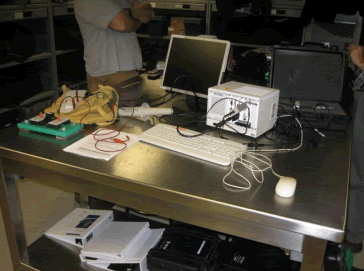Canadian Test Procedure for CEWs
 Conducted Energy Weapons (CEW) are deployed by the Law Enforcement officials as legitimate less lethal alternatives in the use of force continuum. As public interest in CEWs has risen over the past several years, there have been questions surrounding the validation and testing of these weapons. In 2009 some provincial jurisdictions (notably Alberta and BC) directed that all CEWs in use in that jurisdiction be tested in accordance with the manufacturer’s performance specification. There were approaches to validating the performance of CEWs which replicated both the method and equipment used by the manufacturer. The optics of this latter method were not positive for the general public and the usefulness of limited test data for biomedical research was not apparent. In addition, as inventories of CEWs were ageing, the absence of comprehensive test data (ie regular and consistent) did not provide any useful information on life-cycle management or value-for-money questions surrounding the acquisition and use of CEWs. There were no scientifically supportable indicators of weapon failure or indicators of failure.
Conducted Energy Weapons (CEW) are deployed by the Law Enforcement officials as legitimate less lethal alternatives in the use of force continuum. As public interest in CEWs has risen over the past several years, there have been questions surrounding the validation and testing of these weapons. In 2009 some provincial jurisdictions (notably Alberta and BC) directed that all CEWs in use in that jurisdiction be tested in accordance with the manufacturer’s performance specification. There were approaches to validating the performance of CEWs which replicated both the method and equipment used by the manufacturer. The optics of this latter method were not positive for the general public and the usefulness of limited test data for biomedical research was not apparent. In addition, as inventories of CEWs were ageing, the absence of comprehensive test data (ie regular and consistent) did not provide any useful information on life-cycle management or value-for-money questions surrounding the acquisition and use of CEWs. There were no scientifically supportable indicators of weapon failure or indicators of failure.
During 2009 and 2010 two Workshops on CEWs were held at Carleton University in Ottawa. International medical, police, scientific and engineering experts discussed a range of topics and concluded that a common test standard for testing CEWs was necessary.
Consequently as a result of these deliberations, an ad hoc group of experts from Carleton University, MPB Technologies, Canadian Police Research Center, and Datrend Inc. created a Test Procedure for Conducted Energy Weapons which addressed concerns of transparency surrounding testing of CEWs. That test procedure was subsequently published in the summer of 2010 (click here to download).
The Canadian Test Procedure contains indexes specific to two weapons in use in Canada: the M-26 and the X-26. More importantly the procedure addresses larger questions of standardized testing, good engineering practices, key definitions, and data analysis and test equipment. The Canadian Test Procedure is a comprehensive document which includes, for the first time, a reference to a safety standard (maximum charge) using an international standard for pulsed emissions.
The Canadian Test Procedure includes CEW performance data which can be set alongside the manufacturer’s performance specification. This specification indicates the range of satisfactory performance for pulse repetition rate, maximum voltage, maximum current, pulse duration and net charge based on an average of the last 8 pulses in a pulse train.
However, The Canadian Test Procedure will require data acquisition on every pulse in a 5 second firing interval, interpulse distance, monophasic charge and total charge. The Canadian Test Procedure recommends a reporting format and several data fields (such as physical inspection, environmental detail and mechanical observations).
The Canadian Test Procedure is an evergreen document which will be updated as testing experiences become more widespread and consistent. It brings consistency and transparency to the validation of the performance of Conducted Energy Weapons in use in Canada. The Canadian Test Procedure has been embraced by police, and provincial authorities for regular performance testing of CEWs.